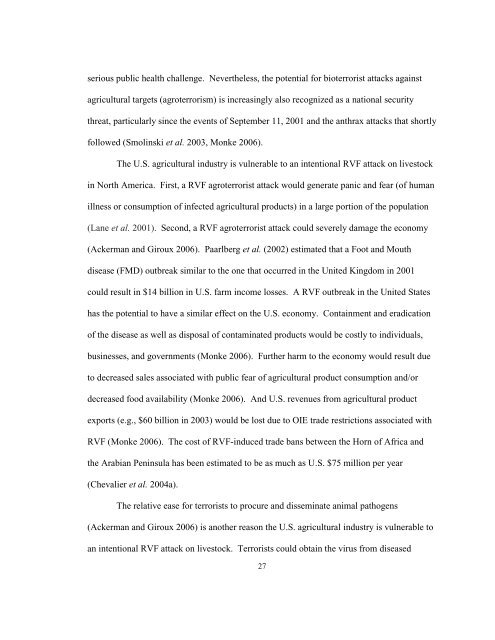Sample A: Cover Page of Thesis, Project, or Dissertation Proposal
Sample A: Cover Page of Thesis, Project, or Dissertation Proposal
Sample A: Cover Page of Thesis, Project, or Dissertation Proposal
Create successful ePaper yourself
Turn your PDF publications into a flip-book with our unique Google optimized e-Paper software.
serious public health challenge. Nevertheless, the potential f<strong>or</strong> bioterr<strong>or</strong>ist attacks against<br />
agricultural targets (agroterr<strong>or</strong>ism) is increasingly also recognized as a national security<br />
threat, particularly since the events <strong>of</strong> September 11, 2001 and the anthrax attacks that sh<strong>or</strong>tly<br />
followed (Smolinski et al. 2003, Monke 2006).<br />
The U.S. agricultural industry is vulnerable to an intentional RVF attack on livestock<br />
in N<strong>or</strong>th America. First, a RVF agroterr<strong>or</strong>ist attack would generate panic and fear (<strong>of</strong> human<br />
illness <strong>or</strong> consumption <strong>of</strong> infected agricultural products) in a large p<strong>or</strong>tion <strong>of</strong> the population<br />
(Lane et al. 2001). Second, a RVF agroterr<strong>or</strong>ist attack could severely damage the economy<br />
(Ackerman and Giroux 2006). Paarlberg et al. (2002) estimated that a Foot and Mouth<br />
disease (FMD) outbreak similar to the one that occurred in the United Kingdom in 2001<br />
could result in $14 billion in U.S. farm income losses. A RVF outbreak in the United States<br />
has the potential to have a similar effect on the U.S. economy. Containment and eradication<br />
<strong>of</strong> the disease as well as disposal <strong>of</strong> contaminated products would be costly to individuals,<br />
businesses, and governments (Monke 2006). Further harm to the economy would result due<br />
to decreased sales associated with public fear <strong>of</strong> agricultural product consumption and/<strong>or</strong><br />
decreased food availability (Monke 2006). And U.S. revenues from agricultural product<br />
exp<strong>or</strong>ts (e.g., $60 billion in 2003) would be lost due to OIE trade restrictions associated with<br />
RVF (Monke 2006). The cost <strong>of</strong> RVF-induced trade bans between the H<strong>or</strong>n <strong>of</strong> Africa and<br />
the Arabian Peninsula has been estimated to be as much as U.S. $75 million per year<br />
(Chevalier et al. 2004a).<br />
The relative ease f<strong>or</strong> terr<strong>or</strong>ists to procure and disseminate animal pathogens<br />
(Ackerman and Giroux 2006) is another reason the U.S. agricultural industry is vulnerable to<br />
an intentional RVF attack on livestock. Terr<strong>or</strong>ists could obtain the virus from diseased<br />
27




![[Sample B: Approval/Signature Sheet] - George Mason University](https://img.yumpu.com/21978828/1/190x245/sample-b-approval-signature-sheet-george-mason-university.jpg?quality=85)


![[Sample B: Approval/Signature Sheet] - George Mason University](https://img.yumpu.com/18694905/1/190x245/sample-b-approval-signature-sheet-george-mason-university.jpg?quality=85)






![[Sample B: Approval/Signature Sheet] - George Mason University](https://img.yumpu.com/18694552/1/189x260/sample-b-approval-signature-sheet-george-mason-university.jpg?quality=85)


![[Sample B: Approval/Signature Sheet] - George Mason University](https://img.yumpu.com/18694474/1/190x245/sample-b-approval-signature-sheet-george-mason-university.jpg?quality=85)